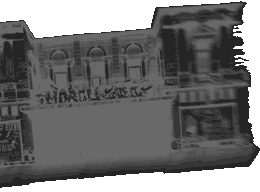|
The Rote Flora stands as an interfering political factor in the local suburbs and beyond. The house works along the lines of autonomous projects and is broadly used by different fractions within the left wing scene. This has resulted in deep political and cultural bonds between the house and the people: squatters, neighbours, users, visitors and associates all over the world. Due to this the Flora is very often an important component for broader and larger mobilisations. As one of the last squats in Germany it is a place of potential disorder in an environment of restructuring and polishing the surrounding suburbs.
There are many myths about squats: Rubbish Mountains, Chaos and Anarchy are some of the most common. The Flora fulfils mostly the first two myths. But for us, the status of a squat contains more than holding on to a charming location. Foremost stands the possibility of generating and filling a political and cultural space. Nearly no other space is as inspiring, stimulating and sometimes spectacular as one that is illegal. The form of organisation within this squat, its public relations and the diversity of its users has grown from this melting pot.
Of course, one of the pillars in the ongoing success of the house is that nobody earns any money. The entire income of the house flows back into its renovation and construction or is used as a support for mostly local cultural, political and social projects. There are close ties between this practical work and the status of being on an illegal terrain. This was the state of being in the past and still is.
Squats are visual cracks in the hegemonic order of the civil society: Inspirations; and mirrors of the current resistant cultural movements. The Rote Flora is one of the multiple outcomes of a desire for change. A turning point marked by provoking revellers and melodramatic fighters. The house is a persistent nightmare in the graticule of urban planners and oppressors of revolutionary sprouts - the disharmony in an environment of tune and consistence.
And we really love to cause some vexations.
Projects like the Flora draw their essence from their usage. As such, the old building is far more than just a house for us. The project gathers political and cultural activities in and around its walls. Self-determination and collectivism are palpable phrases. There we pass again the mountains of rubbish; the expression of our prosperities and failures. The project lives through constant changes due to the fact that cemented utopias often adhere disappointment, anger and frustration. Some people only begin to get involved into the Flora, while others take a break or stop their involvement completely.
The usage of some of the rooms in the building changes frequently, others remain the same as in the first squatting day and another corner is either a dumpster, or is without any use. Although this is only how it appears on the surface, because unused areas are not useless at all. Areas such as modern city ruins and deserted, shabby places in the public space develop at some point their own life as an antagonism for their former appearance.
So hands out of the pockets and let's start the exploration of the town. Places and spaces of resistance can be found everywhere: proliferations of the Flora and other weeds who whisper in the night into to the ears of the establishment, "erase yourself — you've got no chance to win".
Their virtual bliss will finally fade. Watch out!
|
